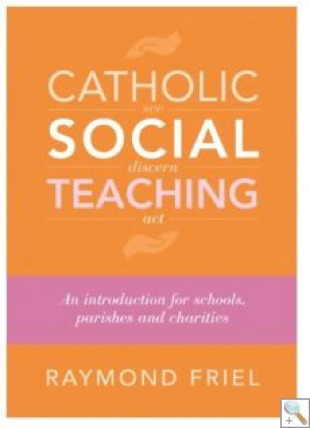Catholic Social Teaching: A NEW Book and My Review
"Where the rubber meets the road."
Catholic Social Teaching (CST) is sometimes called the Church's best-kept secret. It is our most straightforward way to understand the teachings of Jesus, especially when we read the parables. A place to start and to know where to begin is to go back and read MT 5-6-7 & 25. Then, read Raymond Friel's new book, "Catholic Social Teachings": An "Introduction for Schools, parishes and Charities.
Why is this book important?
All too often, we find ourselves reading articles and books. They give us an excellent understanding of CST's meaning, history, and importance. But all too often, we are left scratching our heads and saying, "Where" do I begin in my…."
The teachings of Jesus, the early followers of Jesus who best understood his message and tried to live the teachings, is where we find the proverbial "where "the rubber meets the road." How do we translate this into our lives today and our work?
Raymond focuses on this problem. He uses schools, parishes, and charities as the place to start. I suggest you read this book and experiment with substituting your workplace, your neighborhood, and the civic organizations you belong to as you read it and see how it applies just as well.
Catholic Social Teachings are all about changing our lives and the lives around us. On the book's cover, you will see the words SEE-JUDGE-ACT.
Raymond helps the reader understand the See Judge Act method, the pedagogical approach that Cardinal Joseph Cardijn developed in the early 20th century when faced with what he saw as the ills of the Industrial Revolution and the dignity of workers and students.
The book walks the reader through the three-step social analysis and action process, focusing on our schools, charities, and parishes. If we reflect, we see in the history of the social movements of the Church the center focus was on schools, charities, and parishes. In our modern world, we have drifted away from that focus, and as you read this book, it will help you help others refocus on the mission. Our role is to help people understand the meaning of the Kingdom of God; you will find the book is a handy tool to:
1. See: What is the art of observing and immersing oneself in a particular situation or problem, and why is it necessary to understand? The book encourages active observation and demonstrates processes and steps to go beyond surface appearances to understand the root causes of issues.
2. Discern/Judge: Throughout the book, Raymond helps the reader take the following steps to critically analyze the situation, considering its ethical and social implications for the environment and situation. This involves applying one's value principles to make informed judgments about right and wrong, especially in justice, the care of creation, and the person's dignity.
3. Act: Finally, the See Judge Act method calls for addressing the identified problems. This could involve individual or collective action, advocating for change, or implementing solutions. Raymond provides the reader with excellent examples of using Vatican II documents and the popes' encyclicals. He offers a wealth of resources, such as websites, reading materials, and advocacy models that will aid us in implementing the action plan.
Throughout the book, you will find references and resources to aid in understanding the importance of CST as a way of living our lives in the Kingdom of God here and as Jesus called us to do. It all begins with the Gospels and the inspired pathway to a reconciled society in harmony through justice and love. This is about change. Societal change starts not with the government but with you, me, and our communities.
Raymond Friel introduces the treasure of the scriptures. He provides helpful quotes to stimulate our thinking about the message. The book is essential for teams working together and realizing not everyone in our circle of influences understands CST. The book will be a valuable resource for beginners and the experienced. It will provide ongoing education as a refresher for all of us working in the world of change for the Kingdom.
The book provides an outstanding guide to the principles of the greater good, with helpful references to scripture and the key Church documents to pull it all together.
In Part Two of the book, "Catholic Social Action, Spot the CST," Raymond helps the reader understand better the examples. He clarifies that all this teaching is meant to inspire people to build a better world founded on truth, justice, and love. When we think of the work of Joseph Cardijn, we see how this book helps us in the art of innovation, education, and collaboration with those around us and our communities. To make the connections, Raymond provides examples from frontline charities and schools. The examples show how CST looks when "the rubber" meets the road." The book "needs to be in everyone's hands, working for the greater good of the common good in the Kingdom of God.
"The Church" needs all of its lay folk, not just the clergy, to bring the Kingdom of God into the present-day world." ~ Louis " Putz CSC 1957
Published by Redemptorist Publications. ISBN 978085231 640 5
https://www.rpbooks.co.uk/catholic-social-teaching
Hopefully, it will be on Amazon in the US soon.


